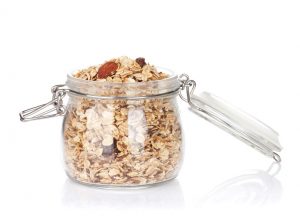Incredibly Edibly Addictive Sugar
 Sugar is delicious, but don’t kid yourself, it’s incredibly addictive. We’re evolutionary programmed to think so. Sugar isn’t intrinsically good or bad, but human beings’ genetically mandated love of the stuff combined with the fact that it is incredibly cheap and ubiquitous spells trouble.
Sugar is delicious, but don’t kid yourself, it’s incredibly addictive. We’re evolutionary programmed to think so. Sugar isn’t intrinsically good or bad, but human beings’ genetically mandated love of the stuff combined with the fact that it is incredibly cheap and ubiquitous spells trouble.
How Does Sugar Affect Your Body?
For the purposes of this next section, when I say sugar, I mean added sweeteners of any kind, because any sweetener causes the same host of problems when eaten in excess. A few of the names you might find on labels include cane sugar, evaporated cane juice, maple syrup, honey, rice syrup, agave, coconut sugar, corn syrup, dextrose, evaporated cane juice, fruit juice concentrate, high fructose corn syrup etc. Sugar naturally found in whole fruit, vegetables, or milk, doesn’t count. Calorie free sweeteners also don’t count, though I beg you to steer clear of NutraSweet (aspartame), Splenda (sucralose) and saccharine (Sweet N’ Low). They are toxic. Stevia is generally fine in small amounts, and xylitol is well tolerated by some while others get some digestive upset from it as it is not absorbed. Be aware though, that even non-calorie sweeteners contribute to an addiction to excessively sweet foods.
I talk to all of my patients about limiting sugar. It may not be necessary for everyone to avoid cane sugar entirely like I do, but most people could benefit from eating less of it.
Table sugar is made up of half glucose and half fructose
All the other sweeteners I listed above contain some ratio of these 2 sugars. Glucose and fructose are processed very differently by the body. Glucose is mainly what the body needs to function (though you don’t have to eat sweet things to get enough of it because your body gets plenty from complex carbs found in whole grains, legumes and vegetables, and can even make its own out of fat and protein). Fructose, while fine in moderate amounts found in fruit is very taxing to the liver in high amounts. I encourage you to watch Sugar: The bitter truth for more on how your body processes glucose and fructose.
 The body’s goal is to maintain the level of glucose in the blood at a very specific level because that is what the brain needs to be happy. When blood glucose drops too low, you feel terrible. Foggy thinking, irritability, nausea, and fatigue: these are all common feelings when your blood sugar drops too low and your brain is expressing its displeasure. On the other hand, the brain doesn’t protest when blood sugar is too high. If it did, we likely wouldn’t have such high rates of diabetes in this country because people would receive consistent negative feedback from their bodies when they overindulged.
The body’s goal is to maintain the level of glucose in the blood at a very specific level because that is what the brain needs to be happy. When blood glucose drops too low, you feel terrible. Foggy thinking, irritability, nausea, and fatigue: these are all common feelings when your blood sugar drops too low and your brain is expressing its displeasure. On the other hand, the brain doesn’t protest when blood sugar is too high. If it did, we likely wouldn’t have such high rates of diabetes in this country because people would receive consistent negative feedback from their bodies when they overindulged.
The pancreas produces 2 hormones that are responsible for keeping your blood sugar in the perfect middle range:
- When blood sugar levels are too high, Insulin tells your cells to remove sugar from the blood and store it as glycogen in the liver, and as fat all over the body, but especially around the midsection.
- When blood sugar levels are too low, Glucagon tells your cells to add sugar to the blood.
But what if blood sugar levels are bumped up over and over again throughout the day because you regularly eat sugary meals or snacks, and this continues for days, months, or years on end? Over time your cells stop listening when insulin tells them to remove sugar from the blood. Like a child who no longer listens to her mom nagging her to clean her room, cells all over the body quit listening to insulin telling them to clean up the sugar. When this happens, sugar levels remain high, eventually leading to type 2 diabetes. High sugar levels in the blood begin to gum up the blood vessels as well other cells in the body. This leads to heart disease and speeds up the aging process. If you’re interested in slowing or reversing the aging process, listen up. The first and best way is to keep your blood sugar levels in the normal range. All of that excess sugar floating around directly causes wrinkles and sagging skin.
So What Are Some Basic Guidelines to Aim for Around Eating Sugar?
I generally recommend that my patients focus on sticking to the American Heart Association’s recommendations, which say that:
Women should aim to consume no more than 6 teaspoons (24 grams) of added sugar per day
Men should aim to consume no more than 9 teaspoons (36 grams) of added sugar per day
Children up to age 8 should consume no more than 3-4 teaspoons (12-16 grams) per day
Children ages 8 to 18 should consume no more than 5-6 teaspoons (20-24 grams) per day
An important conversion to keep in mind is that there are 4 grams of table sugar in 1 teaspoon. Most nutrition labels list sugar in grams, so this helps with label reading.
The US Food and Drug Administration recommends that people not exceed 10% of their daily calories from added sugar. That works out to about 50 grams of sugar per day or 12.5 teaspoons of table sugar. That’s over double the American Heart Association’s recommendations for women and much too high in my opinion.
My Favorite Granola
I recently made my own granola, modifying a recipe from Food 25 to reduce the sweetener and only use maple syrup. I ended up with a completely delicious crunchy, mildly sweet and ever so slightly salty granola that I absolutely love. I love that this recipe contains a ton of nuts and seeds lending it a relatively high protein content. Pumpkin and sunflower seeds are some of my favorite super foods as they’re packed with minerals. This granola is also high in healthy fats from the coconut flakes, nuts, seeds, and olive oil. I enjoy it with some whole fat yogurt and fresh berries to increase the antioxidant punch. I’ve listed the nutrition facts below the recipe.
An important thing to note is that even though it has relatively low sugar, I still consider this granola a treat and don’t eat it every day. My goal is to make the majority of my diet veggies, fruits, legumes, whole grains and occasional meat. In order to eat enough veggies each day, it takes eating vegetables with most meals, and having granola for a meal usually means I don’t eat vegetables. So I reserve it for special occasions or times when I’m in a bit of a hurry.
Here’s the Recipe

Ingredients:
3 cups gluten free rolled oats
1 cup hulled raw pumpkin seeds
1 cup hulled raw sunflower seeds
1 cup unsweetened coconut chips
1 cup raw pecans, left whole or coarsely chopped
½ cup pure maple syrup
½ cup extra-virgin olive oil
1 scant teaspoon coarse salt
Directions:
- Heat oven to 300 degrees F.
- Place oats, pumpkin seeds, sunflower seeds, coconut, pecans, syrup, olive oil, and 1 scant teaspoon salt in a large bowl and mix until well combined. Spread granola mixture in an even layer on a rimmed baking sheet. Transfer to oven and bake, stirring every 10 to 15 minutes, until granola is toasted, about 45 minutes
- Remove granola from oven and season with more salt to taste. Let cool completely before serving or storing in an airtight container for up to 1 month.
- Serving size: ½ cup
- Makes about 14 servings
Per serving (approximate):
Total fat: 29g
Omega-3 fats: 257mg
Potassium: 369mg
Total carbohydrate: 33g
Dietary fiber: 6.5g
Added sugar: 5g
Protein: 11g
Vitamin A: 47IU
Calcium: 42mg
Iron: 4mg
Magnesium: 151mg
Selenium: 7mcg
Zinc: 3.6mg
Granola Boasts Impressive Protein Content
Looking at these stats, I’m impressed with the protein content. One of my main objections to eating granola or oatmeal for breakfast (besides that it usually means skipping vegetables) is that it has fairly low protein content unless you’re adding protein rich toppings. Eleven grams of protein is great! The fiber content and omega 3 fats are good, too. I’m very impressed with the amount of potassium, iron, magnesium and zinc in this granola. It is loaded with minerals! Though it is true that minerals are less well absorbed with eaten with grains. The added sugar of 5 grams per serving is nice and low, and it still tastes amazing, especially with added berries or other fresh fruit. The fat content of 29g is fairly high, but as I am always trying to impress upon my patients, added sugar is the main culprit for weight gain and metabolic disease, not fat. The fats in this recipe are all very healthy, and a higher fat content means you don’t crave added sugar as much. You’ll likely feel more satisfied by this granola than a lower fat variety, meaning you won’t be craving additional snack foods after eating it.
Crunchily,
Dr. Jennea Wood
Check Out Our Sugar Free Summer Course Here
Image Copyright: <a href=’https://www.123rf.com/profile_artanika’>artanika / 123RF Stock Photo</a>
Image Copyright: <a href=’https://www.123rf.com/profile_majo1122331′>majo1122331 / 123RF Stock Photo</a>
 Dr. Jennea Wood, ND is a board-licensed naturopathic physician. She provides a unique fusion of conventional medical testing and diagnosis, attention to modern research, and safe, effective natural therapeutics to help you reach your health goals. Dr. Wood earned her Doctorate of Naturopathy from National College of Natural Medicine (NCNM). During her time there, she completed a six-month internship in integrative cardiology and well as additional extensive training in chronic gastrointestinal conditions including small intestine bacterial overgrowth (SIBO). She has advanced training in classical homeopathy through the New England School of Homeopathy, and has worked with the Food as Medicine Institute since 2013 delivering high quality nutrition education. She loves to work with people in treating all manner of health concerns using natural therapies such as homeopathy, botanical medicine, hydrotherapy and nutrition.
Dr. Jennea Wood, ND is a board-licensed naturopathic physician. She provides a unique fusion of conventional medical testing and diagnosis, attention to modern research, and safe, effective natural therapeutics to help you reach your health goals. Dr. Wood earned her Doctorate of Naturopathy from National College of Natural Medicine (NCNM). During her time there, she completed a six-month internship in integrative cardiology and well as additional extensive training in chronic gastrointestinal conditions including small intestine bacterial overgrowth (SIBO). She has advanced training in classical homeopathy through the New England School of Homeopathy, and has worked with the Food as Medicine Institute since 2013 delivering high quality nutrition education. She loves to work with people in treating all manner of health concerns using natural therapies such as homeopathy, botanical medicine, hydrotherapy and nutrition.
